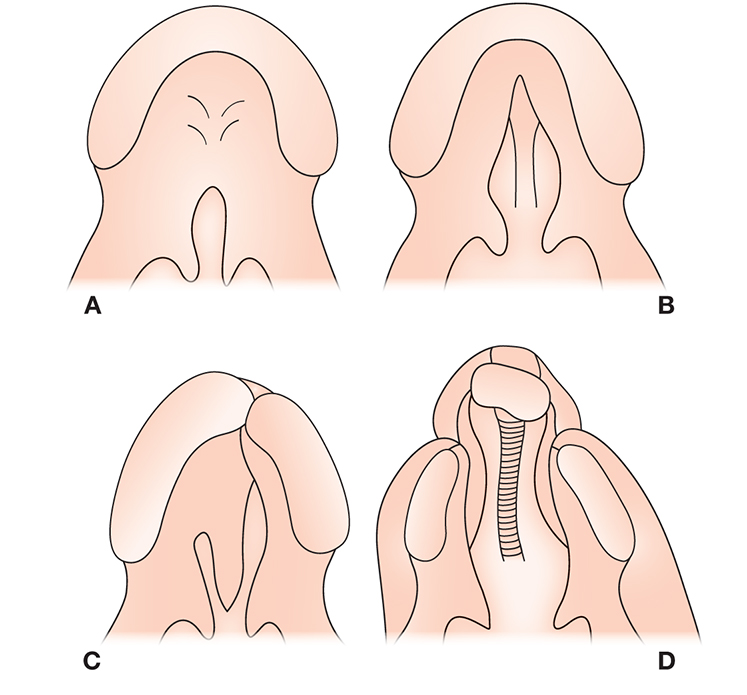A.1. Describe the anatomic defects of a cleft palate and a cleft lip.
Answer:
Congenital clefts of the upper lip occur because of failed fusion of the maxillary, medial, and lateral nasal processes. They vary from a notch in the upper lip to a partial cleft through the lip and the floor of the nose involving the alveolar ridge, or they can be complete cleft of the lip and the palate.
The cleft palate is divided into prepalatal and postpalatal clefts. The incisive foramen marks the boundary between the two, and each arises differently during embryologic development. A prepalatal cleft involves the anterior palate, alveolus, lip, nostril floor, and ala nasi. Postpalatal clefts can extend anywhere from the soft and hard palate to the incisive foramen. A submucosal cleft exists when a bone defect is present without a mucosal defect. The most common cleft of the palate is a left-sided, complete cleft of the prepalatal and palatal structures. The second most common is a midline cleft of the entire soft palate and part of the hard palate without involvement of the prepalatal area. Various degrees of the cleft palate and lip are shown in Figure 42.1.
Figure 42.1.: Various Degrees of Cleft Palate and Cleft Lip.

Various degrees of cleft palate and cleft lip. A. Cleft of the soft palate only. B. Cleft of the soft and hard palate as far forward as the incisive foramen. C. Complete unilateral alveolar cleft, usually involving the lip. D. Complete bilateral alveolar cleft, usually associated with bilateral clefts of the lip. (Modified from McCarthy JG, Cutting CB, Jogan VM. Introduction to Facial Clefts. In: McCarthy JG, ed. Plastic Surgery. Vol. 4: Cleft Lip and Palate and Craniofacial Abnormalities. WB Saunders; 1990: 2443.)
References
- Ganske IM, Rogers-Vizena CR. Cleft lip and palate: principles and treatment. In: Chung KC, ed. Grabb and Smith's Plastic Surgery. 9th ed. Wolters Kluwer; 2025:183-196.
- Schafer S, Card E, Liao EC. Cleft lip and palate: embryology and genetics. In: Chung KC, ed. Grabb and Smith's Plastic Surgery. 9th ed. Wolters Kluwer; 2025:197-208.
- Schindler E, Martini M, Messing-Jünger M. Anesthesia for Plastic and Craniofascial Surgery. In: Andropoulous DB & Gregory GA, ed. Gregory's Pediatric Anesthesia. 6th ed. Wiley-Blackwell; 2020: 904-905.

